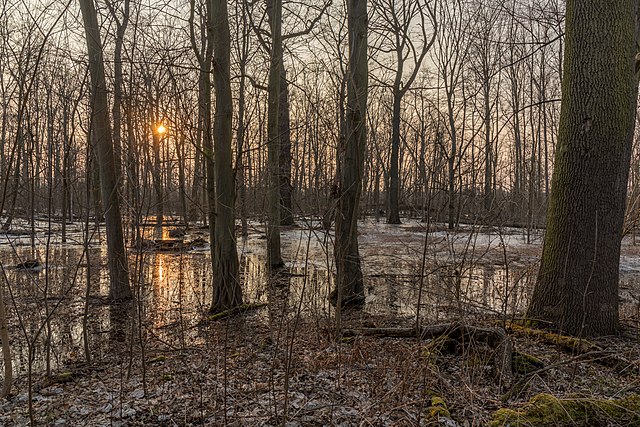Top Qs
Timeline
Chat
Perspective
Leipzig Riverside Forest
Europe's largest inner-city alluvial forest From Wikipedia, the free encyclopedia
Remove ads
Leipzig Riverside Forest (German: Leipziger Auenwald) is one of the largest lowland Riparian forests in Central Europe, lying mostly within the city limits of Leipzig city in Germany. The nature reserve is partially covered with hardwood forest and contains a large variety of endangered species. [citation needed]




Remove ads
Location
This section includes a list of references, related reading, or external links, but its sources remain unclear because it lacks inline citations. (November 2023) |

Leipzig Riverside Forest is divided into separate southern and northern parts, between which is a corridor containing many parks and green areas along the banks of the White Elster. Between the two there is a certain ecological link through a corridor that comprises parks and grassland and which lies along the Elster Basin, which was constructed to provide flood protection, the Elster flood plain and other water bodies of the Leipzig River Network. The total area covered is approx. 2500 hectares.
Leipzig Riverside Forest is a nature reserve.
Remove ads
Flora and fauna
Plants
Originally, the hardwood forest hosted more elms and black poplars which have become rare over the years, however the amount of old oaks with massive stems is still remarkable. The mixed forest contains many different tree species, almost half of them are either ash, maple or sycamore maple. Also found are small-leaved linden, common horn beam and various kinds of willows.[1] In spring, the ground is covered with wild garlic, sprinkled with spring snowflakes and corydalis in colors ranging from white and pink to purple. Some rather rare plants like the Geum rivale can also be found in the wet, almost swampy parts of the area.[2]
Animals
The common kingfisher has become quite rare in Germany, especially due to loss of habitat and as a result some waterways are closed-off from tourist paddling during the breeding season.[3] Inhabiting the forest are red squirrels and a multitude of woodpeckers, such as the great spotted woodpecker, as well as the black woodpecker and the European green woodpecker.[4]
Remove ads
See also
Literature
- ENEDAS e. V./ Autorenkollektiv: Der Leipziger Auwald. Ein Natur- und Erlebnisführer. Edition Leipzig, 2013, ISBN 978-3-361-00685-0.
- Gerd K. Müller (ed.): Der Leipziger Auwald – ein verkanntes Juwel der Natur. Leipzig, 1992.
- Gerd K. Müller: Die Leipziger Auen. Staatsministerium für Umwelt und Landesentwicklung, Dresden, 1995.
References
External links
Wikiwand - on
Seamless Wikipedia browsing. On steroids.
Remove ads
